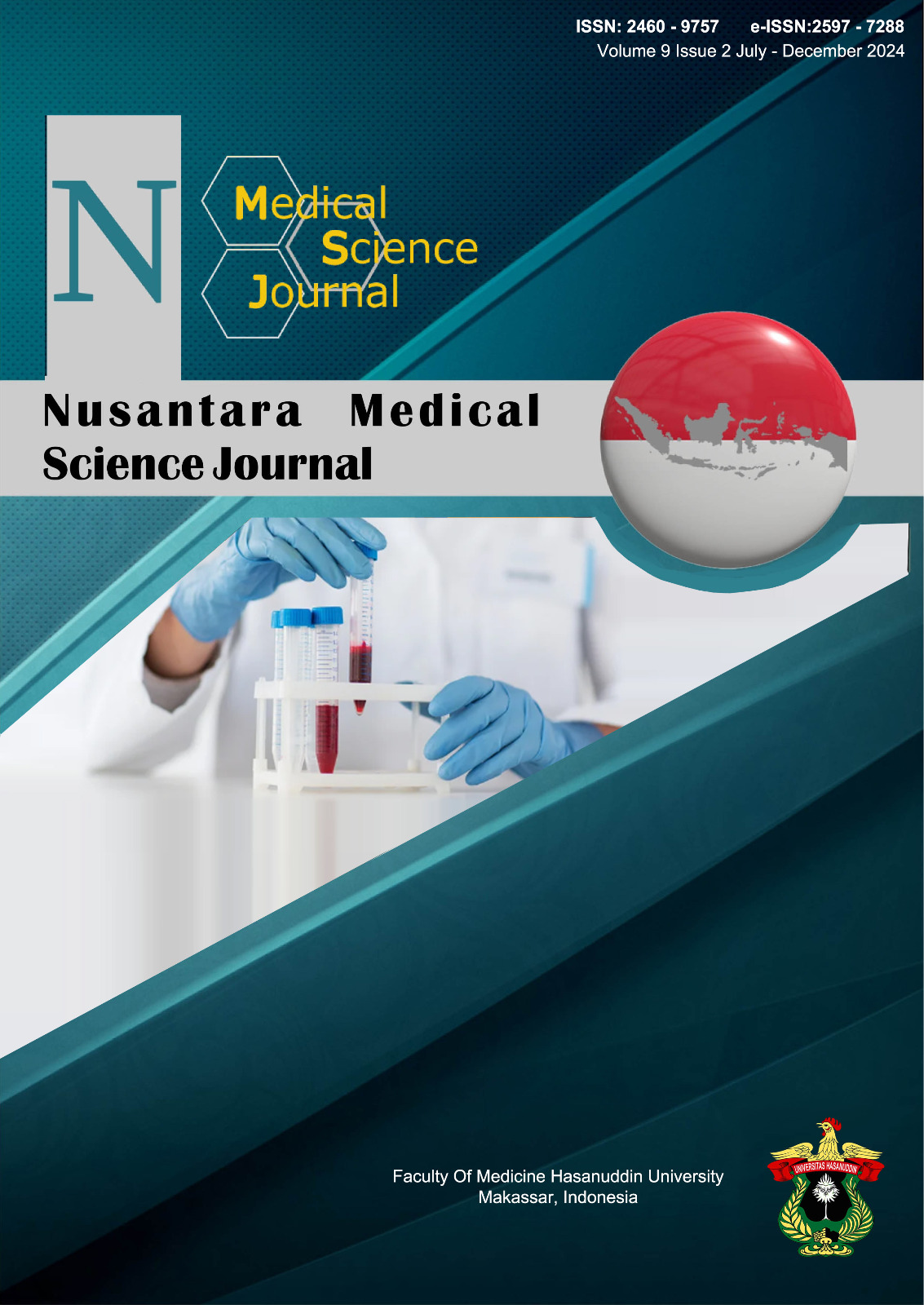Surgical Treatment Of Pendred Syndrome With Thyroid Nodule: A Case Report
Abstract
Introduction and importance: Pendred syndrome (PS) is a genetic disease inherited in an autosomal recessive pattern. In PS patients, the ability of thyroid gland to accumulate iodide in the follicle lumen is disrupted, causing insufficient thyroid hormone synthesis and goiter to occur as compensation. However, this symptom does not often appear, as goiter is only detected in 30–75% of PS patients.
Presentation of case: A 33-year-old Buginese man complained of a painless mass in the neck. In the past 3 months, the mass has shown rapid growth, followed by symptoms of agitation, irritability, and hyperhidrosis. The patient was previously diagnosed with nodular goiter and was taking Levothyroxine. Furthermore, there was a history of the same disease in the patient’s grandmother and younger sibling. Physical examination showed grade III goiter (WHO criteria) with hard consistency and no palpable nodules. Laboratory tests showed routine blood tests, kidney and liver function in normal limits, 1.14 ng/dL FT4, free triiodothyronine level of 6.07 pg/dL, and 2,401 mIU/L TSH level. Chest X-ray results showed tracheal narrowing at the level of the superior thoracic aperture. Similarly, thyroid USG showed that the size of the right lobe was enlarged and anechoic. CT (Computerized Tomography) scan of the cervix showed diffuse enlargement in each lobe and the patient was diagnosed with PS. Right isthmolobectomy and thyroid biopsy were carried out and pathological anatomical examination results showed thyroid follicular nodular disease with cystic degeneration. After surgery, thyroxine hormone replacement therapy was continued.
Discussion: Surgical intervention strategies may be employed to inhibit the advancement of disease and mitigate thyroid enlargement, consequently decreasing the likelihood of obstruction and malignancy.
Conclusions: In cases of PS with large thyroid nodules pressing on the trachea, isthmolobectomy was carried out to obtain good results and no recurrence.
References
1. Sanei-Moghaddam A, Wilson T, Kumar S, Gray R. An unfortunate case of Pendred syndrome. Vol. 125, Journal of Laryngology and Otology. 2011. p. 965–7.
2. Tesolin P, Fiorino S, Lenarduzzi S, Rubinato E, Cattaruzzi E, Ammar L, et al. Pendred syndrome, or not pendred syndrome? That is the question. Genes (Basel). 2021 Oct 1;12(10).
3. Rozenfeld J, Efrati E, Adler L, Tal O, Carrithers SL, Alper SL, et al. Transcriptional regulation of the pendrin gene. Cell Physiol Biochem. 2011;28(3):385–96.
4. Suzuki H, Oshima A, Tsukamoto K, Abe S, Kumakawa K, Nagai K, et al. Clinical characteristics and genotype-phenotype correlation of hearing loss patients with SLC26A4 mutations. Acta Otolaryngol. 2007;127(12):1292–7.
5. Min Soh L, Druce M, Grossman AB, Differ AM, Rajput L, Bitner- M, et al. EVALUATION OF GENOTYPE-PHENOTYPE RELATIONSHIPS IN PATIENTS REFERRED FOR ENDOCRINE ASSESSMENT IN SUSPECTED PENDRED SYNDROME 2 3 [Internet]. Available from: http://www.healthcare.uiowa.edu/labs/pendredandbor/slcMutations.htm
6. Bizhanova A, Kopp P. Genetics and phenomics of Pendred syndrome. Mol Cell Endocrinol. 2010 Jun 30;322(1–2):83–90.
7. Wémeau JL, Kopp P. Pendred syndrome. Best Pract Res Clin Endocrinol Metab. 2017 Mar;31(2):213–24.
8. Chen N, Tranebjærg L, Rendtorff ND, Schrijver I. Mutation Analysis of SLC26A4 for Pendred Syndrome and Nonsyndromic Hearing Loss by High-Resolution Melting. The Journal of Molecular Diagnostics. 2011 Jul;13(4):416–26.
9. Smith N, U-King-Im JM, Karalliedde J. Delayed diagnosis of Pendred syndrome. BMJ Case Rep. 2016 Sep 12;2016.
10. Tong GX, Chang Q, Hamele-Bena D, Carew J, Hoffman RS, Nikiforova MN, et al. Targeted Next-Generation Sequencing Analysis of a Pendred Syndrome-Associated Thyroid Carcinoma. Endocr Pathol. 2016 Mar 7;27(1):70–5.
11. Sasaki T, Onaga R, Koshu R. Case of delayed presentation of Pendred syndrome with a large goitre causing a life-threatening airway obstruction. BMJ Case Rep. 2022 Jun 6;15(6):e250990.
12. Hu EW, Liu LB, Jiang RY, He XH. Goiter and hearing impairment: A case of a male patient with Pendred syndrome. Oncol Lett. 2014 Nov;8(5):2059–62.
13. van Nierop JWI, Huinck WJ, Pennings RJE, Admiraal RJC, Mylanus EAM, Kunst HPM. Patients with Pendred syndrome: is cochlear implantation beneficial? Clin Otolaryngol. 2016 Aug;41(4):386–94.
14. Sakurai K, Hata M, Hishinuma A, Ushijima R, Okada A, Taeda Y, et al. Papillary thyroid carcinoma in one of identical twin patients with Pendred syndrome. Endocr J. 2013;60(6):805–11.
Downloads
Published
How to Cite
Issue
Section
License
Copyright (c) 2025 Djonny Ferianto, Salman Ardi Syamsu, Vannes Caesar Palebangan Sapan, Indra, Elridho Sampepajung, John Pieter Jr

This work is licensed under a Creative Commons Attribution 4.0 International License.









